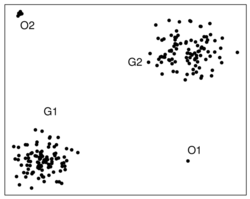Outlier (nonfiction): Difference between revisions
(Created page with "In statistics (nonfiction), an '''outlier''' is an observation point that is distant from other observations. == Description == An outlier may be due to variability in t...") |
No edit summary |
||
| (5 intermediate revisions by the same user not shown) | |||
| Line 1: | Line 1: | ||
[[File:Two-dimensional_Outliers_Example.png|250px|thumb|Example of two-dimensional outliers. Point labeled O1 and points labeled O2 deviate significantly from regions labeled G1 and G2.]]In statistics, an '''outlier''' is an observation point that is distant from other observations. | |||
An outlier may be due to variability in the measurement or it may indicate experimental error; the latter are sometimes excluded from the data set. | An outlier may be due to variability in the measurement or it may indicate experimental error; the latter are sometimes excluded from the data set. | ||
Outliers can occur by chance in any distribution, but they often indicate either measurement error or that the population has a heavy-tailed distribution | Outliers can occur by chance in any distribution, but they often indicate either measurement error or that the population has a heavy-tailed distribution. | ||
In most larger samplings of data, some data points will be further away from the sample mean than what is deemed reasonable. This can be due to incidental systematic error or flaws in the theory that generated an assumed family of probability distributions, or it may be that some observations are far from the center of the data | In most larger samplings of data, some data points will be further away from the sample mean than what is deemed reasonable. This can be due to incidental systematic error or flaws in the theory that generated an assumed family of probability distributions, or it may be that some observations are far from the center of the data. | ||
Outlier points can therefore indicate faulty data, erroneous procedures, or areas where a certain theory might not be valid. | |||
However, in large samples, a small number of outliers is to be expected (and not due to any anomalous condition). | |||
== In the News == | |||
<gallery mode="traditional"> | |||
File:Allumette Empyrées.jpg|link=Les Empyrées|''Allumette emflammée'', symbol of ''[[Les Empyrées]]'', accidentally sets fire [[French Revolution (nonfiction)|French Revolution]]. | |||
</gallery> | |||
== Fiction cross-reference == | |||
* [[Database Database]] - an English language nursery rhyme. | |||
* [[Les Empyrées]] | |||
== Nonfiction cross-reference == | == Nonfiction cross-reference == | ||
* [[Data (nonfiction)]] | * [[Data (nonfiction)]] | ||
* [[French Revolution (nonfiction)]] | |||
* [[Mathematics (nonfiction)]] | |||
* [[Statistics (nonfiction)]] | * [[Statistics (nonfiction)]] | ||
External links: | |||
* [https://en.wikipedia.org/wiki/Outlier Outlier | * [https://en.wikipedia.org/wiki/Outlier Outlier] @ Wikipedia | ||
[[Category: | [[Category:Nonfiction (nonfiction)]] | ||
[[Category: | [[Category:Mathematics (nonfiction)]] | ||
Latest revision as of 09:22, 22 June 2016
In statistics, an outlier is an observation point that is distant from other observations.
An outlier may be due to variability in the measurement or it may indicate experimental error; the latter are sometimes excluded from the data set.
Outliers can occur by chance in any distribution, but they often indicate either measurement error or that the population has a heavy-tailed distribution.
In most larger samplings of data, some data points will be further away from the sample mean than what is deemed reasonable. This can be due to incidental systematic error or flaws in the theory that generated an assumed family of probability distributions, or it may be that some observations are far from the center of the data.
Outlier points can therefore indicate faulty data, erroneous procedures, or areas where a certain theory might not be valid.
However, in large samples, a small number of outliers is to be expected (and not due to any anomalous condition).
In the News
Allumette emflammée, symbol of Les Empyrées, accidentally sets fire French Revolution.
Fiction cross-reference
- Database Database - an English language nursery rhyme.
- Les Empyrées
Nonfiction cross-reference
External links:
- Outlier @ Wikipedia

